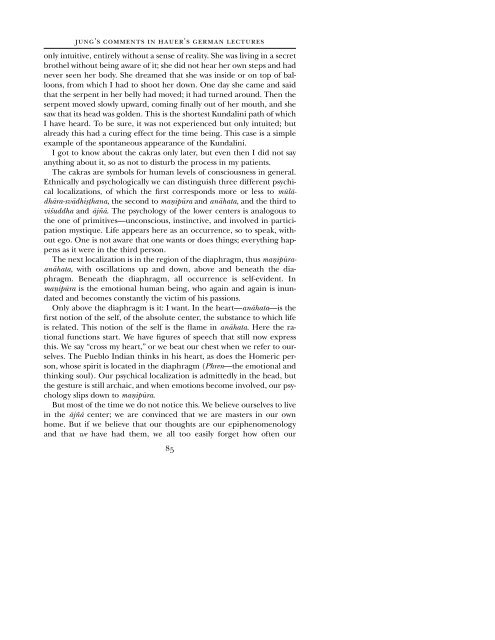CG JUNG - Countryside Anarchist
CG JUNG - Countryside Anarchist
CG JUNG - Countryside Anarchist
Create successful ePaper yourself
Turn your PDF publications into a flip-book with our unique Google optimized e-Paper software.
<strong>JUNG</strong>'S COMMENTS IN HAUER'S GERMAN LECTURES<br />
only intuitive, entirely without a sense of reality. She was living in a secret<br />
brothel without being aware of it; she did not hear her own steps and had<br />
never seen her body. She dreamed that she was inside or on top of balloons,<br />
from which I had to shoot her down. One day she came and said<br />
that the serpent in her belly had moved; it had turned around. Then the<br />
serpent moved slowly upward, coming finally out of her mouth, and she<br />
saw that its head was golden. This is the shortest Kundalini path of which<br />
I have heard. To be sure, it was not experienced but only intuited; but<br />
already this had a curing effect for the time being. This case is a simple<br />
example of the spontaneous appearance of the Kundalini.<br />
I got to know about the cakras only later, but even then I did not say<br />
anything about it, so as not to disturb the process in my patients.<br />
The cakras are symbols for human levels of consciousness in general.<br />
Ethnically and psychologically we can distinguish three different psychical<br />
localizations, of which the first corresponds more or less to mÖlvdhvra-svvdhiü°hana,<br />
the second to maõipÖra and anvhata, andthethirdto<br />
viçuddha and vjñv. The psychology of the lower centers is analogous to<br />
the one of primitives—unconscious, instinctive, and involved in participation<br />
mystique. Life appears here as an occurrence, so to speak, without<br />
ego. One is not aware that one wants or does things; everything happens<br />
as it were in the third person.<br />
The next localization is in the region of the diaphragm, thus maõipÖraanvhata,<br />
with oscillations up and down, above and beneath the diaphragm.<br />
Beneath the diaphragm, all occurrence is self-evident. In<br />
maõipÖra is the emotional human being, who again and again is inundated<br />
and becomes constantly the victim of his passions.<br />
Only above the diaphragm is it: I want. In the heart—anvhata—is the<br />
first notion of the self, of the absolute center, the substance to which life<br />
is related. This notion of the self is the flame in anvhata. Here the rational<br />
functions start. We have figures of speech that still now express<br />
this. We say “cross my heart,” or we beat our chest when we refer to ourselves.<br />
The Pueblo Indian thinks in his heart, as does the Homeric person,<br />
whose spirit is located in the diaphragm (Phren—the emotional and<br />
thinking soul). Our psychical localization is admittedly in the head, but<br />
the gesture is still archaic, and when emotions become involved, our psychology<br />
slips down to maõipÖra.<br />
But most of the time we do not notice this. We believe ourselves to live<br />
in the vjñv center; we are convinced that we are masters in our own<br />
home. But if we believe that our thoughts are our epiphenomenology<br />
and that we have had them, we all too easily forget how often our<br />
85


